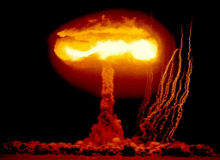

Signed by a number of military specialists, a letter from the EMP Task Force, delivered to the White House last month, claims that an EMP attack – a radio wave that damages and destroys electronic systems – would bring the US economy to a halt.
The signatories note: "The consequent failure of critical infrastructure that sustain our lives is a major national security threat and would be catastrophic to our people and our nation." Hard-hitting words, indeed.
As well as this, a 2012 document from the US Intelligence Council, entitled Global Trends 2013, highlighted an EMP attack as one of eight ‘Black Swan’ events – in other words something that could irrevocably damage civilisation as we know it.
NASA has claimed that the chance of a geomagnetic storm – a form of natural EMP – hitting Earth is 12% per decade. In 2012 a similar storm narrowly missed Earth and the Carrington event of 1859 caused electrical currents to surge through telegraph systems.
On top of natural disasters is the threat of manmade nuclear weapons. If detonated in the sky, the resultant explosion would produce electromagnetic radiation.
Such a scenario was first demonstrated in 1962 when the US detonated a bomb at a height of 240 miles in the Pacific Ocean. The after-effects caused telephone outages in Hawaii and damaged streetlights.
Twenty-five years on from the Treaty on Conventional Armed Forces in Europe (CFE), the world is a very different place.
More recently, in 2013 it was reported that North Korea was developing an EMP weapon. The Task Force letter also states that Russia and China have nuclear EMP capabilities, with Russia actively developing a super-high-frequency gun that can deactivate unmanned aerial vehicles and precision weapons.
The threat was further highlighted in March, when a secret Iranian military document described a potential nuclear EMP attack in 20 different locations in the US.
However, one of the biggest players in the EMP game is the US itself, with the country’s air force announcing in May that the Counter-electronics High-powered microwave Advanced Missile Project can be deployed using the Joint Air-to-Surface Standoff Missile-Extended Range.
Countering the threat
There is no doubting the seriousness with which the signatories believe in the threat and their recommendations, which include protecting nuclear reactors.
In an article for the Wall Street Journal last year, Dr Peter Vincent Pry, who served on the EMP Commission – set up to study the nature and magnitude of potential high-altitude EMP threats, among other things – and James Woolsey, chairman of the Foundation for Defense of Democracies and a former director of the CIA, wrote that "literally millions of American lives could depend" on increased protection against EMPs. So what can be done?
One course of action is called hardening. This involves designing, or modifying, electronic systems to cope with a pulse by using thicker conductors. The Task Force urges Obama to insist that such technology be used on the electrical grid, as it has been by the Department of Defense for nuclear systems and military installations. This includes surge arrestors and Faraday cages, as well as micro-grids.
The cost of these upgrades for the national grid was estimated at $2bn in 2008 by the EMP Commission.
UK MPs warned in 2012 that the potential impact of an EMP weapon "could be devastating and long-lasting for UK infrastructure", adding it was "vitally important that the work of hardening infrastructure is begun now and carried out as a matter of urgency".
In 2013 Republican Representative Trent Franks introduced the Critical Infrastructure Protection Act, but according to the US Congress website the last action of the bill was referral to the Committee on Homeland Security and Governmental Affairs.
In the same year the Fraunhofer Institute in Germany unveiled a device that detects the strength, frequency and location of an attack, but this would only be useful for small-scale attacks.
What this points to, however, is a general lack of forward planning when it comes to civilian infrastructure. While it could be claimed that the EMP Task Force letter is exaggerating the threat, the consequences of not protecting at least the critical elements such as nuclear reactors are vast.
The EMP catastrophe may never materialise, but it’s wiser to plan as if it will rather than burying our heads in the sand.



